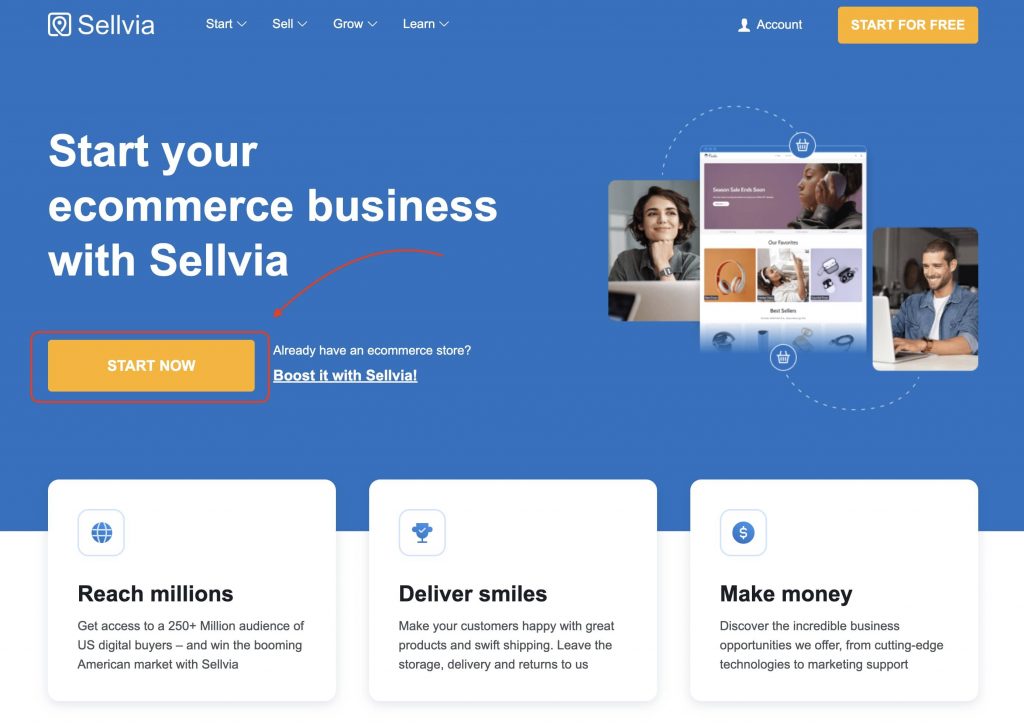Pro Methods On Selecting Sellvia Shopify Dropshipping Services
Pro Methods On Selecting Sellvia Shopify Dropshipping Services
Blog Article
What Are The Customer Service And Support Characteristics Of An Amazon Seller? Shopify Or Wordpress Services For Dropshipping In Us Markets?
The importance of evaluating the support and customer service features when dropshipping products to the U.S. on Amazon Seller Shopify or WordPress (WooCommerce) is paramount, as customer satisfaction relies heavily on quick and efficient communication and prompt resolution of issues. Here's a guide to evaluating the tools for customer support on each platform and capabilities.
1. Amazon Seller
Amazon Customer Support Policies
Amazon has strict guidelines on when and how you can communicate with clients. All customer inquiries should be addressed within 24 hours. This can be an extremely difficult task.
FBA sellers are able to make it easier to process refunds and returns since Amazon's FBA handles the process. In the case of Merchant Fulfilled Network (MFN) it is necessary to handle returns, refunds and inquiries directly, which requires solid customer service procedures.
Support for Sellers
Seller Support Services: Amazon provides seller support through its Seller Central platform, through which you can find information, FAQs, live chat and email support for resolving issues such as managing your account, issues with orders, and policy questions.
Performance Metrics: Amazon holds sellers accountable to certain metrics, such as the Order Defect Rate (ODR) and response times. Poor customer services can lead account suspensions. Therefore, it's important to provide reliable customer service.
Steps to Assessment for Amazon Sellers:
Examine your response: Read Amazon's customer response time requirements and make sure you have the capacity or the tools needed to meet them (such automated response systems).
Return handling If you're using MFN, check to see if either your fulfillment partner or supplier provide support for returns. Amazon handles returns when you choose to use FBA. It is important to monitor any issues and make sure that your customers are happy.
Customer Service Tool: Make sure that you are familiarized with Seller Central’s tools for handling refunds, disputes, and general questions. Third-party tools can help you comply with Amazon's strict standards for responses within a certain timeframe.
2. Shopify
Integrated Customer Services Apps
Shopify is integrated with Gorgias Zendesk and Re to provide customer support.
It has dashboards that allow customers to easily handle their inquiries using multiple channels: email, chat and social media.
Automated Communication: Many applications on Shopify provide automated responses, chatbots and FAQs that aid customers to quickly find answers to frequently asked questions.
Shopify offers a wide range of options for customizing messages such as email confirmations, emails to abandon cart and messages to follow up with clients. This will help to build customer loyalty and satisfaction.
Notifications and Tracking of Orders
Shopify provides customers with real-time notifications regarding order status as well as updates on shipping and delivery tracking. Transparency helps reduce the amount of customer inquiries.
Customer Order Status Page for Customer Order Status Shopify allows customers to view their order status via an order status page, which reduces the requirement to contact support.
Shopify: Steps for Assessing the Platform
Consider Available Apps. Gorgias provides omnichannel service and is integrated directly into Shopify.
Customer Communication Flexibility: Look at Shopify's options for customizable email templates, automated replies, and chatbots to make sure that your customers have timely and relevant interactions.
After-Sale Support: Find out whether the platform provides solutions for customer service following sales like returns labels or simple refund processing through third-party apps. Shopify can streamline customer satisfaction and return processes.
3. WordPress (WooCommerce).
Customer Service Plug-ins
WooCommerce offers a range of live chat and customer service plugins, including Zendesk (Zendesk), Help Scout (Help Scout) as well as LiveChat. These can be integrated directly into your web site. These tools offer live chat, knowledge bases and customer service tickets.
Automated Chatbots. To get rapid responses, you can use AI-based ChatBot plugins.
Email Notifications WooCommerce provides customized email notifications that contain orders confirmations, shipping details and delivery. Customers will be updated about their orders.
Returns and Order Tracking Management:
Order Tracking: TrackShip provides real-time order tracking information that customers are able to get on your site. It helps reduce inquiries regarding orders.
Returns & Refunds WooCommerce has a customizable refund and return policies. WooCommerce also offers plugins for automated returns, like WooCommerceRMA. This makes it simpler to handle refunds.
Evaluation Steps for WooCommerce:
Select Reliable Customer Support Plugins Consider plugins that support live chat, ticketing, and chatbots. WooCommerce users love LiveChat as well as Help Scout because they offer customer support integrated within the program.
Automated Communication and Tracking: Automated communication and tracking of orders. Make status updates easy to access to customers. This will reduce inquiries about the status of an order. TrackShip is an application that automatizes notification notifications.
WooCommerce offers you a lot of flexibility when setting the policies for refunds and returns. Use plugins to handle returns and make it simpler for your customers. Have a look at the pro Sellvia review for site advice including best items to sell online, starting an ecommerce business from scratch, ecommerce company, best thing to sale online, online business to buy, sell products online, starting an online company, make an online store, ecommerce solution, start online business and more.
How Best To Assess The Customer Feedback And Support
Dropshipping platforms like Amazon Seller and Shopify (WooCommerce), it is vital to evaluate the feedback of customers and their support. Each platform comes with different levels of support for customers and feedback mechanisms that can influence the business's success as well as customer satisfaction. This article will help you assess these aspects across three platforms.
1. Amazon Seller
Customer Feedback:
Amazon offers customers the ability to rate and review products on a scale from 1 to 5 stars. Feedback is essential for the brand's reputation and can have a significant influence on sales. Ratings that are high boost visibility and credibility.
Seller feedback: Buyers may leave feedback for certain sellers. This will influence the overall rating of the seller as well as performance metrics. A negative feedback, especially if it is consistent, can reduce visibility and even result in account suspension.
Q&A section - Customers may submit questions to sellers and other customers. This section can be used to clarify specifications of the product and build trust.
Customer Support Features
Amazon Customer Service: Amazon provides a robust customer service platform. Amazon handles all customer support for FBA Orders. Sellers have to manage customer support for orders fulfilled by merchants.
Return Policy: Amazon's return policy is friendly to customers, with simple return processes that increase trust among consumers but aren't easy for sellers to manage.
Seller Support Amazon provides dedicated support to its sellers. This includes assistance via Seller Central and tools to solve issues related to account health, performance metrics and dispute with sellers.
Assessment Methods for Amazon Sellers:
Analyze Seller Metrics. Check your feedback and ratings for sellers to determine areas that need improvement. When you begin to build your credibility, you should aim to achieve high ratings.
Monitor Customer Reviews: Check reviews of your products and ask questions from customers regularly to ensure you're responding to customer concerns promptly and ensuring the quality of your product.
Utilize Amazon's resources. Be familiar with the features that support you from Amazon Seller Central, such as the ability to receive performance notifications and resolution options.
2. Shopify
Customer Feedback Mechanisms
Shopify Store Review: Sellers are able to integrate customer review applications, such as Judge.me or Yotpo that allow customers to leave reviews directly on the product pages. Feedback from customers is essential to drive sales and establishing trust.
Social proof: Shopify stores frequently use social proof to increase sales. This can be done by using testimonials, user-generated content or case studies on social media. This boosts the credibility of the store and draw more customers.
Shopify merchants can use surveys after purchase to gather information about customer satisfaction and experience. The data is utilized to improve the customer experience.
Customer Support Features
24/7 Support available 24 hours a day: Shopify provides round-the-clock support via live chat, email as well as phone. Shopify offers 24/7 support for businesses, allowing the merchants to seek assistance as required.
Shopify Help Center. A complete resource center that contains tutorials, articles and forums. It provides guidance on many topics, including store design marketing strategies, setup and many more.
Shopify offers a variety of customer service tools like Zendesk and Gorgias which can aid you in streamlined customer service, handle tickets and improve communication.
Assessment Steps for Shopify:
Evaluation of Feedback Integration: Find the most effective review application to use, and also how you can motivate your customers to provide feedback following the purchase.
Test Support Channels for Testing: Speak to Shopify support to evaluate response times and the level of support provided.
Help Center Resources: Get familiar with the Shopify Help Center so you can effectively solve issues.
3. WordPress (WooCommerce).
Customer Feedback Mechanisms:
WooCommerce provides built-in reviews for its products. Customers can provide feedback and ratings. Sellers are able to moderate reviews in order to ensure that they are appropriate and of high quality.
Feedback Plugins Many WooCommerce stores utilize plugins that enhance review systems, such as YITH WooCommerce Advanced Reviews or feedback forms that allow for precise feedback from customers.
Social Media Integration WooCommerce stores often ask customers to leave reviews on their social media sites that can be posted on product pages to enhance credibility.
Customer Support Features
WooCommerce customers rely on documentation and forums to troubleshoot. WooCommerce Help Docs are extensive, but support isn't the same speed as Shopify.
Hosting Support Many WooCommerce merchants use managed hosting services that provide customer service. Support may differ significantly between hosting companies.
WooCommerce's flexible support systems allow sellers to decide how they want to respond when customers contact them.
WooCommerce assessment steps:
Examine Review Functionality: Make sure that product review features have been activated. Also, evaluate any additional review plugins to improve feedback mechanisms.
Test the hosting support Contact support to find out how responsive they are and what kind of support is available.
Create a Support system: Integrate a helpdesk, or ticketing systems to manage customer questions better. Take a look at the recommended Sellvia reviews for more guide including online selling, sellvia login, opening e commerce business, ecommerce platform, buy online business for sale, sell online website, sale business online, selling products online from home, drop shipping how to, start a dropshipping business and more. 